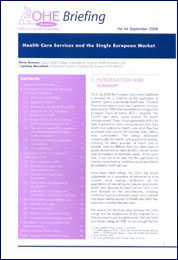Sign up to our newsletter Subscribe
Health Care Services and the Single European Market

Legislation in the EU provides incentives for the developmeng of drugs for rare diseases, known as orphan medicinal products (OMPs). At a recent conference, OHE’s Dr Mestre-Ferrandiz reported on OHE research that examines the impact of these measures as well as whether and how pricing and reimbursement policies affect access in practice.

Martina Garau
Orphan drugs, or orphan medicinal products (OMPs), are meant to diagnose, prevent or treat life-threatening or debilitating diseases in small patient populations. In the US, an orphan disease is defined as one affecting no more than an average of 7.5 per 10,000 people; in the EU, the number is 5 per 10,000. Efforts to encourage the development of OMPs began with the Orphan Drug Act in the US in 1983, followed by the EU Regulation on Orphan Medicinal Products in 1999. Both contain incentives meant to encourage development by providing tax credits and/or stipulating periods of market and/or data exclusivity. Both also offer an accelerated approval processes. The EU legislation also allows a single, EU-wide marketing authorisation for OMPs.
The incentives have made a difference. Between 2001 and 2009, 68 OMPs were approved for use in the EU; since 2006, nearly 12 OMPs have been approved, on average, every year. This rate is expected to remain fairly constant going forward.
Encouraging development and speeding approval is very important, but that alone does not ensure that OMPs are available to patients. Formal and informal policies and procedures for determining pricing and reimbursement (P&R) also affect access. OHE’s Dr. Jorge Mestre-Ferrandiz recently presented the results of comparative research on these factors at the 9th Annual Pricing and Reimbursement Conference in late September.
The OHE study compares P&R policy for 43 OMPs across seven EU Member States: France, Germany, Italy, The Netherlands, Spain, Sweden and the UK. In particular, the study examines: the standards of evidence and the criteria for P&R decisions, the availability of access before full licensing approval, and requirements for studies after the drug is available on the market. Dr Mestre-Ferrandiz emphasised that OMPs present special challenges for evidence collection, both before and after licensing. Because the patient population is small by definition, minimal epidemiologic and disease burden data are available, diagnostic systems are suboptimal, and very few health care professionals are trained in the diagnosis and treatment of each rare disease.
OHE’s research shows that requirements and practice vary substantially across the seven countries in the study. For example, when access decisions are based primarily on clinical evidence, countries are flexible in their criteria and their approach, accepting lower risk-benefit ratios for OMPs than for other new medicines. When a formal health technology assessment (HTA) process is required, however, evidence requirements are the same as for non-OMP drugs (except in The Netherlands). Countries also vary with respect to pre-market access and requirements for post-launch studies.
Decisions based on HTA can affect P&R and, as a result, access to OMPs by patients. In countries without formal HTA requirements, nearly all OMPs included in the OHE study were considered eligible for reimbursement. In the UK, the Scottish HTA body has rejected some of these and/or recommended restricted use. Sweden has the highest rate of rejection (almost 70% are not reimbursed).
OMPs account for a small portion of total drug spending, an average of 1.7 percent in 2007 in the top five EU countries. Dr Mestre-Ferrandiz pointed out, however, that low spending levels will not necessarily protect OMPs from demands for more evidence. Continuingly scarce health care resources may create demands for cost effectiveness evidence even for OMPs. This would create serious challenges: OMPs are approved by the EMA on an accelerated basis, which means that data required for HTA are less likely to be available at that time than for other new medicines. As noted above, collecting additional data, after approval, also can be problematic because of the nature of rare diseases.
To meet these challenges, Dr Mestre-Ferrandiz recommends greater cooperation across countries to develop a more robust evidence base for OMPs. Data will need to be collected and research conducted across countries at the European and international levels. Moreover, in order to ensure timely access to new OMPs, much of this research will need to be done after the drug appears on the market. Finally, cooperation across stakeholders is essential; interactions involving the EMA, HTA bodies and sponsors early in the development process can help avoid delays by identifying potential evidence issues then and developing ways to address them.
Download Garau, M. and Mestre-Ferrandiz, J. (2009) Access mechanisms for orphan drugs: A comparative study of selected European countries. OHE Briefing. London: Office of Health Economics.